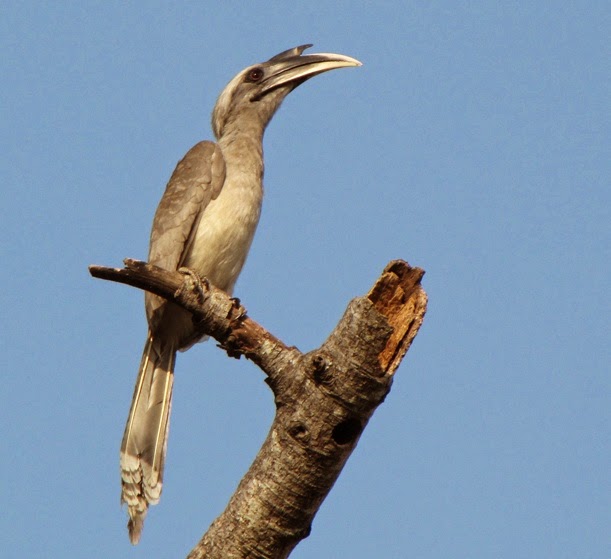 |
| Photo by Sreya Dutta (Flickr) |
Common name:
Indian grey hornbill (en); calau-cinzento-indiano (pt); calao de Gingi (fr); cálao gis indio (es); keilschwanztoko (de)
Taxonomy:
Order Coraciiformes
Family Bucerotidae
Range:
This species is found throughout most of India and northwards into north-eastern Pakistan, southern Nepal and north-western Bangladesh.
Size:
These birds are 50-60 cm long and weigh 240-375 g.
Habitat:
The Indian grey hornbill is mostly found in dry tropical forests and dry savannas, also using arable land and rural gardens.
Diet:
They feed mainly on small fruits, namely those of Streblus asper, Cansjera rheedii, Carissa carandas, Grewia tiliaefolia, Lannea coromandelica, Ficus spp., Sterculia urens and Securinega leucopyrus. They also take invertebrates such as molluscs, insects and scorpions, small birds, mice and lizards and, rarely, flower petals.
Breeding:
Indian grey hornbills breed in February-June. They are monogamous, and sometimes show co-operative breeding with young males helping the breeding couple. The nest is a natural tree cavity, lined with pieces of bark and placed 6-30 m above the ground. The female closes the entrance of the nest with faeces and mud, remaining inside until the young are near fledging while the male brings her food through a small hole. She lays 2-5 dull white eggs, which are incubated for 4-5 weeks. The chicks fledge about 8 weeks after hatching, with the whole nesting period lasting an average 87 days.
Conservation:
IUCN status – LC (Least Concern)
This species has a large breeding range and is reported to be widespread and often common. The population is suspected to be stable in the absence of evidence for any declines or substantial threats.







